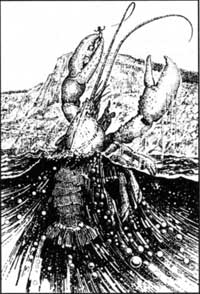Conclusions
To recapitulate: what has been termed here a sacred landscape entails a correlation of physical place and cultural meaning, existing within a larger body of tradition. Its physical elements (a piled rock site, Wizard Island, the lake bottom) have associations with various culturally postulated events, some in a mythic time, others occurring still today. Those who share traditional knowledge of a landscape such as Crater Lake bring to the encounter culturally patterned expectations which shape experience, form symbolic associations, and allow lasting experiential value to be gained.
Under such circumstances the tenacity with which many Indian tribes struggle to preserve their sacred landscapes is understandable, for such areas offer the possibility of sustaining tradition and identity, thus linking the future with the past. The attempt by Karok, Yurok, and other Northwest California peoples to preserve the “High Country” of Del Norte County from logging — the so-called G-O Road case, fought all the way to the U.S. Supreme Court — offers a recent example (see Lyng v. Northwest Indian Cemetery Protective Association, 485 U.S. 439 [1988]).
Within contemporary Anglo-American culture, there is evidence of a collective effort to discover or create such sacred landscapes. The ethos of sublime nature — which a century ago moved the “worthy but untutored” visitors to Crater Lake to tears — is apparently no longer sufficient. Today Anglo-Americans are rather ingenuously urged to seek out “sacred places” culled from the most diverse traditions.23 The acts of the more radical environmental movements (for example, those defending old growth forest); and the vague nature mysticism, coupled with imitation of things Indian, which suffuses many popular therapies — men’s groups taking to the woods to sharpen spears and chant — likewise seem directed toward fashioning sacred places within an increasingly disenchanted world. Whether it is culturally feasible deliberately to create ritual, myth, and sacred landscapes remains to be seen.
This paper has benefited significantly from the assistance of Gordon Bettles, Director of the Cultural Heritage Program, Klamath Tribe (Chiloquin, Oregon); and from Sue Shaffer, Chair of the Cow Creek Band of Umpqua Tribe of Indians (Canyonville, Oregon). Part of the material presented here is taken from a cultural resource overview of Crater Lake National Park, prepared for the National Park Service (Contract CX-9000-9-P013). Support by the NPS, and in particular James Thomson and Fred York of the Seattle Office, is gratefully acknowledged.
Notes
1 Regarding sacred space or sacred landscape, see chapter one in Mircea Eliade (Willard R. Trask, trans.), The Sacred and the Profane: the Nature of Religion (New York: Harcourt, Brace & World, 1959); Linda Grabner, Wilderness as Sacred Space(Washington, DC: Association of American Geographers, 1976); Yi-Fu Tuan, Geopiety: A Theme in Man’s Attachment to Nature and to Place, in David Lowenthal and Martyn J. Bowden (eds.), Geographies of the Mind (New York: Oxford University Press, 1976); and Deward E. Walker, Jr., Protecting American Indian Sacred Geography, Northwest Anthropological Research Notes22 (1988), pp. 253-66.
2 Diane Brazen Gould, The First Amendment and the American Indian Religious Freedom Act: An Approach to Protecting Native American Religion, Iowa Law Review 11 (1986), pp. 869-91; Richard W. Stoffle and Michael J. Evans, Holistic Conservation and Cultural Triage: American Indian Perspectives on Cultural Resources, Human Organization 49(1990), pp. 91-99.
3 Cosgrove, Social Formation and Symbolic Landscape (Totowa, NJ: Barnes & Noble, 1984), p. 185.
4 Linda W. Greene, Historic Resource Study: Crater Lake National Park, Oregon(Denver: USDI-NPS, 1984), p. 271.
5 Harlan D. Unrau, Administrative History, Crater Lake National Park, Oregon (Denver: USDI-NPS, 1988), p. 32.
6 Ibid., p. 33.
7 Ibid., p. 233
8 Grabner, p. 44.
9 Green, p. 28.
10 Ibid., p. 29
11 Robert F. Spencer, Native Myth and Modern Religion among the Klamath Indians,Journal of American Folklore 65 (1952), pp. 217-26.
12 M.A.R. Barker, Klamath Directory, University of California Publications in Linguistics 31 (Berkeley: University of California Press, 1963), p. 145.
13 Spencer, p. 223.
14 Ibid., p. 222.
15 Barker, p. 215.
16 Ibid., p. 389.
17 Theodore Stem, trans., [Myth of] Crater Lake (Lao’s Daughter), narrated in Klamath by Herbert Nelson, 1951. MS on file at Crater Lake National Park.
18 Spencer, p. 222.
19 Leslie Spier, Klamath Ethnography, University of California Publications in American Archaeology and Ethnology 30 (Berkeley: University of California Press, 1930), p. 98.
20 Ibid., p. 96.
21 Ibid.
22 Spencer, p. 222.


